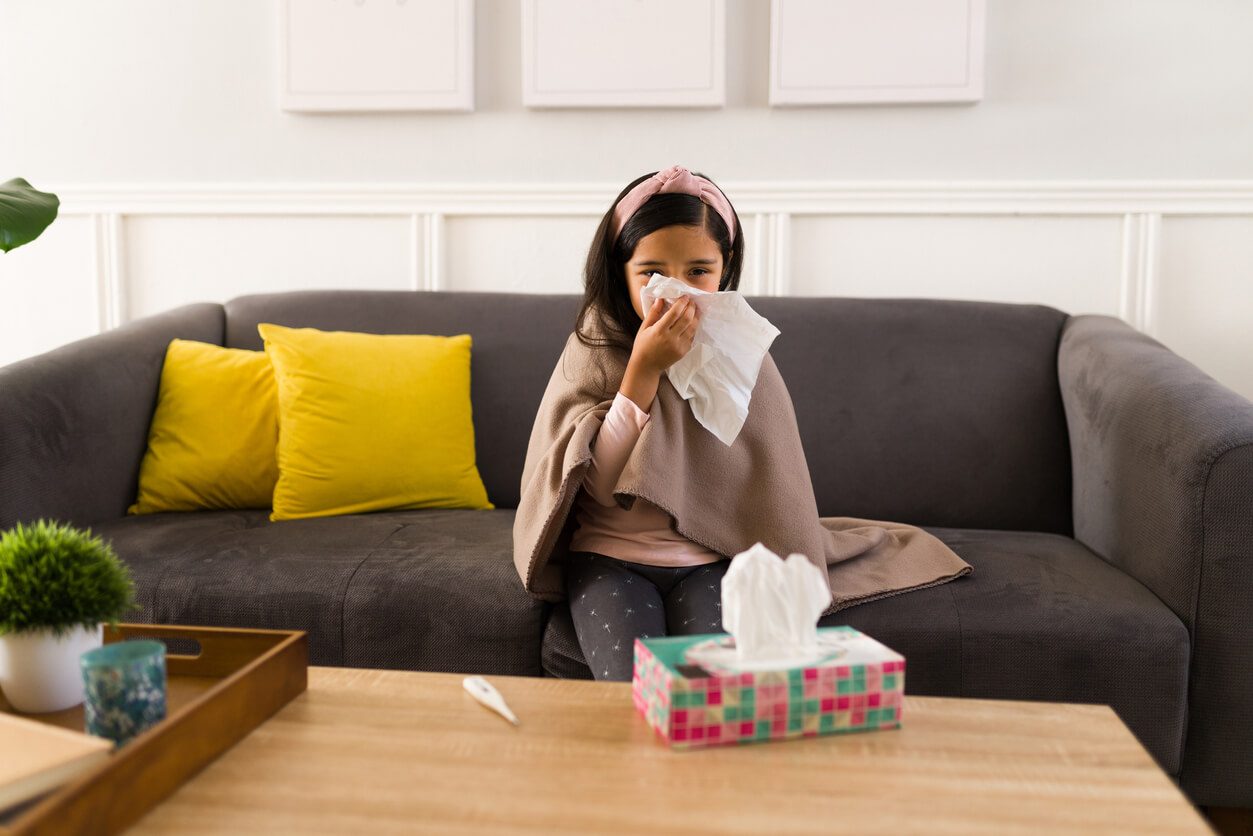Nasal Washes for Children: What You Should Know


Written and verified by the nurse Leidy Mora Molina
Congestion is an annoying symptom in children and it affects their well-being, their eating, and even their rest. Nasal washes decongest the nasal passages when the child has excess mucus due to colds, allergies, or sinusitis.
Although nasal washing is an uncomplicated procedure, it can be quite uncomfortable for the child. For this reason, it’s important to know the correct technique for its performance in order for it to be effective. Find out below when nasal washes are necessary and how to perform this procedure.
Why should we perform nasal washes on children?
During childhood, it’s common for our little ones to suffer from episodes of flu, colds, and allergies. One of the symptoms that accompanies these conditions is nasal congestion, a product of the mucus generated by the respiratory tract in an attempt to get rid of the harmful agents that invade it.
However, the excess of mucus that’s produced is annoying for small children and babies, as they don’t know how to breathe through their mouths and only breathe through their noses. In addition, at this stage, it’s difficult for them to expel their mucus, as the pressure they exert when coughing or sneezing isn’t enough to release these secretions. This causes them difficulties when eating or trying to sleep.
When are nasal washes indicated?
Nasal washes are indicated when the child has a large amount of secretions that prevent free breathing. Although mucus is a defense mechanism of the body, the congestion it produces affects the child’s well-being.
The Spanish Association of Pediatrics approves nasal washes every time the child needs them, especially before feeding, when the child is about to go to sleep, or when they feel uncomfortable for this reason.

What do we need to perform a nasal wash?
Nasal washes are performed with physiological saline solution or saline solution. Either can be chosen, as their efficacy is similar.
One study sought to compare the differences between saline irrigation and other solutions in the treatment of allergic rhinitis in children and adults. The conclusion was that irrigation with saline solution can significantly improve the symptoms of this condition.
It should be taken into account that on the market, there are bottles of solution, sprays, or single doses that facilitate nasal washes.
However, when using the traditional method of nasal washing, the following should be used:
- A 3 or 5 cc syringe.
- A nasal aspirator if the mucus is thick and if your pediatrician recommends it.
How to perform nasal washes in children?
The technique for nasal washes consists of introducing physiological saline or a saline solution through both nostrils, in order to drag the mucus and keep the nostrils clean.
This technique, although simple, requires precision when performing it in order to prevent the child from becoming uncomfortable and complicating the process. Let’s see the steps to perform it:
- Find the right time. It should be away from meals and when the child is calm, as they should remain still in order to avoid injuries.
- Prepare the material to be used.
- Place the child in the appropriate position. If the child is small, position them lying on their side. If the child is older, they should tilt their head toward the sink.
- Gently introduce the saline solution (through the nostril facing the ceiling) until it’s expelled through the nose or mouth. Then, turn the child’s head and repeat through the other nostril.
- Then, it’s best to sit the child down to favor the expulsion of secretions.
When applying the solution, it’s best to use 2 ml in each nostril in infants and 5 ml in older children. If the mucus isn’t very thick, a few drops will be enough.
Is using a nasal aspirator necessary?
Although they’re usually useful, the frequent use of nasal secretion aspirators isn’t recommended. This is because the suction pressure can cause damage to the mucosa and the child’s ear.
It can be used once or twice daily only when the mucus is dense and remains abundant even after nasal lavage.
The nasal aspirators currently recommended are the nozzle type. With them, you can control the suction of the aspirator with your mouth.

Useful tips when performing nasal washes in children
In addition to the above, take into account the following recommendations if you want to practice this technique on your child:
- Nasal lavage should not be performed with the child on their back. This increases the risk of the mucus going into the ear and the development of ear infections.
- There are several systems for nasal washes in children. All of them are valid, as long as they’re done properly.
- If you use sprays or single doses, choose small containers that are for the exclusive use of the child. This avoids contamination of the bottle.
- If the child doesn’t have mucus or isn’t uncomfortable with their secretions, there’s no need to perform a nasal lavage.
- When the nose is very obstructed, it’s best to pour a little solution and massage for a few seconds in order to soften the secretions. Then, perform the nasal lavage.
Nasal washes are safe
Nasal washes are safe and effective for treating excess mucus in children. There are no contraindications for their use and they’re a good option when the child is irritable due to the obstruction that’s generated. Finally, take into account your pediatrician’s recommendations before performing nasal washes.
Congestion is an annoying symptom in children and it affects their well-being, their eating, and even their rest. Nasal washes decongest the nasal passages when the child has excess mucus due to colds, allergies, or sinusitis.
Although nasal washing is an uncomplicated procedure, it can be quite uncomfortable for the child. For this reason, it’s important to know the correct technique for its performance in order for it to be effective. Find out below when nasal washes are necessary and how to perform this procedure.
Why should we perform nasal washes on children?
During childhood, it’s common for our little ones to suffer from episodes of flu, colds, and allergies. One of the symptoms that accompanies these conditions is nasal congestion, a product of the mucus generated by the respiratory tract in an attempt to get rid of the harmful agents that invade it.
However, the excess of mucus that’s produced is annoying for small children and babies, as they don’t know how to breathe through their mouths and only breathe through their noses. In addition, at this stage, it’s difficult for them to expel their mucus, as the pressure they exert when coughing or sneezing isn’t enough to release these secretions. This causes them difficulties when eating or trying to sleep.
When are nasal washes indicated?
Nasal washes are indicated when the child has a large amount of secretions that prevent free breathing. Although mucus is a defense mechanism of the body, the congestion it produces affects the child’s well-being.
The Spanish Association of Pediatrics approves nasal washes every time the child needs them, especially before feeding, when the child is about to go to sleep, or when they feel uncomfortable for this reason.

What do we need to perform a nasal wash?
Nasal washes are performed with physiological saline solution or saline solution. Either can be chosen, as their efficacy is similar.
One study sought to compare the differences between saline irrigation and other solutions in the treatment of allergic rhinitis in children and adults. The conclusion was that irrigation with saline solution can significantly improve the symptoms of this condition.
It should be taken into account that on the market, there are bottles of solution, sprays, or single doses that facilitate nasal washes.
However, when using the traditional method of nasal washing, the following should be used:
- A 3 or 5 cc syringe.
- A nasal aspirator if the mucus is thick and if your pediatrician recommends it.
How to perform nasal washes in children?
The technique for nasal washes consists of introducing physiological saline or a saline solution through both nostrils, in order to drag the mucus and keep the nostrils clean.
This technique, although simple, requires precision when performing it in order to prevent the child from becoming uncomfortable and complicating the process. Let’s see the steps to perform it:
- Find the right time. It should be away from meals and when the child is calm, as they should remain still in order to avoid injuries.
- Prepare the material to be used.
- Place the child in the appropriate position. If the child is small, position them lying on their side. If the child is older, they should tilt their head toward the sink.
- Gently introduce the saline solution (through the nostril facing the ceiling) until it’s expelled through the nose or mouth. Then, turn the child’s head and repeat through the other nostril.
- Then, it’s best to sit the child down to favor the expulsion of secretions.
When applying the solution, it’s best to use 2 ml in each nostril in infants and 5 ml in older children. If the mucus isn’t very thick, a few drops will be enough.
Is using a nasal aspirator necessary?
Although they’re usually useful, the frequent use of nasal secretion aspirators isn’t recommended. This is because the suction pressure can cause damage to the mucosa and the child’s ear.
It can be used once or twice daily only when the mucus is dense and remains abundant even after nasal lavage.
The nasal aspirators currently recommended are the nozzle type. With them, you can control the suction of the aspirator with your mouth.

Useful tips when performing nasal washes in children
In addition to the above, take into account the following recommendations if you want to practice this technique on your child:
- Nasal lavage should not be performed with the child on their back. This increases the risk of the mucus going into the ear and the development of ear infections.
- There are several systems for nasal washes in children. All of them are valid, as long as they’re done properly.
- If you use sprays or single doses, choose small containers that are for the exclusive use of the child. This avoids contamination of the bottle.
- If the child doesn’t have mucus or isn’t uncomfortable with their secretions, there’s no need to perform a nasal lavage.
- When the nose is very obstructed, it’s best to pour a little solution and massage for a few seconds in order to soften the secretions. Then, perform the nasal lavage.
Nasal washes are safe
Nasal washes are safe and effective for treating excess mucus in children. There are no contraindications for their use and they’re a good option when the child is irritable due to the obstruction that’s generated. Finally, take into account your pediatrician’s recommendations before performing nasal washes.
All cited sources were thoroughly reviewed by our team to ensure their quality, reliability, currency, and validity. The bibliography of this article was considered reliable and of academic or scientific accuracy.
- Asociación Española de Pediatría (2013). Lavados nasales. Recuperado de: https://enfamilia.aeped.es/vida-sana/lavados-nasales
- Sociedad valenciana de pediatría (2022). Los lavados nasales: qué son y cuándo deben realizarse. Recuperado de: https://socvalped.com/educacion/2019/lavados-nasales-ninos/
- Peñalba, E. et al. (2022). Lavados nasales en neonatos: ¿son efectivos?. Revista sanitaria de investigación. Recuperado de: https://revistasanitariadeinvestigacion.com/lavados-nasales-en-neonatos-son-efectivos/
- Wang, Y. et al. (2020). Role of nasal saline irrigation in the treatment of allergic rhinitis in children and adults: A systematic análisis. Allergologia et Immunopathologia Vol. 48. Issue 4. pages 360-367. Recuperado de: https://www.elsevier.es/en-revista-allergologia-et-immunopathologia-105-articulo-role-nasal-saline-irrigation-in-S0301054620300264
This text is provided for informational purposes only and does not replace consultation with a professional. If in doubt, consult your specialist.








